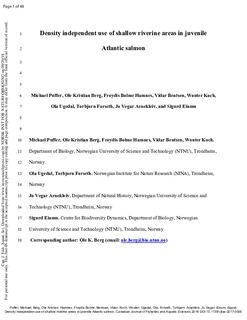| dc.contributor.author | Puffer, Michael | |
| dc.contributor.author | Berg, Ole Kristian | |
| dc.contributor.author | Hamnes, Frøydis Bolme | |
| dc.contributor.author | Bentsen, Vidar | |
| dc.contributor.author | Koch, Wouter | |
| dc.contributor.author | Ugedal, Ola | |
| dc.contributor.author | Forseth, Torbjørn | |
| dc.contributor.author | Arnekleiv, Jo Vegar | |
| dc.contributor.author | Einum, Sigurd | |
| dc.date.accessioned | 2018-09-20T08:23:30Z | |
| dc.date.available | 2018-09-20T08:23:30Z | |
| dc.date.created | 2018-09-14T14:41:36Z | |
| dc.date.issued | 2018 | |
| dc.identifier.issn | 0706-652X | |
| dc.identifier.uri | http://hdl.handle.net/11250/2563558 | |
| dc.description.abstract | Habitat use of aquatic organisms is essential to evaluate effects of many environmental challenges like effects of hydro-power regulation, where stranding may occur under hydropeaking (rapid dewatering of shallow river areas). Experimental studies as well as observations from nature with juvenile Atlantic salmon (Salmo salar) show that the proportion of the population that uses shallow depth was both independent of population density and decreasing with fish size. Experiments were conducted both in the presence and in absence of older fish, during day and night, and during all four seasons. Juvenile salmon from deep areas may therefore distribute into the shallow areas even when fish density becomes reduced. Thus, low density does not lead to reduced stranding risk and shallow areas may therefore function as a sink in a within-generation source-sink dynamic under a repeated hydropeaking scenario. The sink effect of rapid dewatering in shallow areas may be mitigated by e.g. seasonal and diurnal regulation of hydropeaking activity, but dewatering may still result in extinction of weak populations. habitat use, hydropeaking, intracohort competition, intercohort competition, microhabitat use, stranding | nb_NO |
| dc.language.iso | eng | nb_NO |
| dc.subject | habitat use | nb_NO |
| dc.subject | hydropeaking | nb_NO |
| dc.subject | intracohort competition | nb_NO |
| dc.subject | intercohort competition | nb_NO |
| dc.subject | microhabitat use | nb_NO |
| dc.subject | stranding | nb_NO |
| dc.title | Density independent use of shallow riverine areas in juvenile Atlantic salmon | nb_NO |
| dc.title.alternative | Density independent use of shallow riverine areas in juvenile Atlantic salmon | nb_NO |
| dc.type | Journal article | nb_NO |
| dc.type | Peer reviewed | nb_NO |
| dc.description.version | acceptedVersion | nb_NO |
| dc.subject.nsi | VDP::Zoologiske og botaniske fag: 480 | nb_NO |
| dc.subject.nsi | VDP::Zoology and botany: 480 | nb_NO |
| dc.source.journal | Canadian Journal of Fisheries and Aquatic Sciences | nb_NO |
| dc.identifier.doi | 10.1139/cjfas-2017-0500 | |
| dc.identifier.cristin | 1609605 | |
| dc.relation.project | Norges forskningsråd: 193818 | nb_NO |
| cristin.unitcode | 7511,3,0,0 | |
| cristin.unitname | Avdeling for akvatisk økologi | |
| cristin.ispublished | true | |
| cristin.fulltext | postprint | |
| cristin.qualitycode | 1 | |
